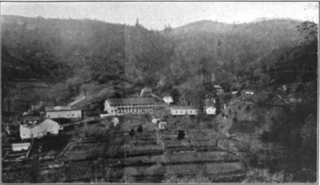
Harbin Hot Springs is a hot spring retreat and workshop center situated at Harbin Springs in Lake County, Northern California. Operated by Heart Consciousness Church, a non-profit, it is named after Matthew Harbin, a pioneer who settled in the Lake County area. Located approximately two hours north of the San Francisco Bay Area, in the United States, the facility suffered partial destruction in the Valley Fire in September 2015, resulting in its temporary closure. It partially reopened in January 2019, including the main pools and sauna, along with a limited cafeteria service.
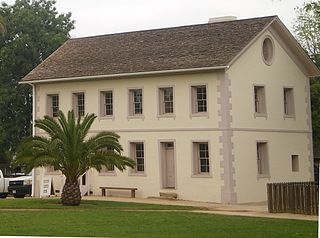
Los Encinos State Historic Park is a state park unit of California, preserving buildings of Rancho Los Encinos. The park is located near the corner of Balboa and Ventura Boulevards in Encino, California, in the San Fernando Valley. The rancho includes the original nine-room de la Ossa Adobe, the two-story limestone Garnier building, a blacksmith shop, a natural spring, and a pond. The 4.7-acre (1.9 ha) site was established as a California state park in 1949.

Wilbur Hot Springs is a naturally occurring historic hot spring, health sanctuary, personal retreat and 1,800-acre (7.3 km2) nature reserve 20+ miles west of Williams, Colusa County, in northern California. It is about 2 hours northeast of the San Francisco Bay Area and 1½ hours north of the Sacramento Airport.

Adams is an unincorporated community in Lake County, California. It was formerly Adams Springs, a summer resort developed around a small group of mineral water springs.

Bartlett Springs is a set of springs around which a resort was developed in Lake County, California. There were four improved springs, each delivering cool carbonated water with considerable amounts of suspended iron. In 1914 it was the largest such resort in Lake County, capable of accommodating up to 500 guests. There was also a bottling plant designed to maintain the natural carbonation as the bottles were filled and capped. It could fill 10,000 per day during the season from May to October when the roads were passable.

Castle Rock Springs was a resort Lake County, California built around a group of mineral springs, including one hot spring with relatively high volumes of water.

Highland Springs is a set of springs which was turned into a resort in the 19th century in Lake County, California. The resort grew to be able to accommodate 200 people, attracted by the curative powers of the mineral waters and the lovely mountain scenery. In the 1920s its popularity waned, the hotel was partly burned, and it passed through various hands before the county claimed eminent domain, bought the property, and flooded it with the Highland Springs Reservoir. The reservoir is surrounded by the Highland Springs Recreation Area, managed by the county.
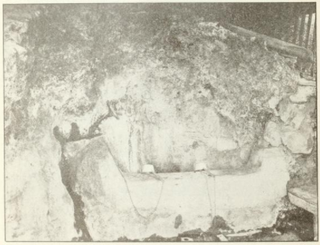
Hough Springs is a set of springs that was turned into a resort in the 19th century in Lake County, California.

Howard Springs is a set of springs turned into a resort in the 1870s in Lake County, California. The resort catered primarily to people interested in the curative powers of the mineral waters. Guests were accommodated in cabins or tents. At one time it had an official post office. The resort changed hands many times over the years, with various changes to the lodge, accommodations and bathhouses, until closing in 1970. For a period it was leased for geothermal exploration. Today it has reopened as a health resort.
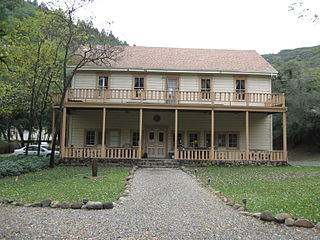
Saratoga Springs is a set of springs that was turned into a resort in the 1870s in Lake County, California. At its peak the resort could accommodate 250 people. The resort was closed after the main hotel burned down, but reopened as a retreat in 1991.

Crabtree Hot Springs is a geological phenomenon in Lake County, California, about 25 miles (40 km) north of Upper Lake. It is located on private property and closed to the public. It lies at an elevation of 2,257 feet. There is a cluster of four natural hot springs at this location, in an isolated narrow winding steep walled canyon on the north bank of the Rice Fork of the Eel River, about one fourth mile downriver from its junction with Salt Creek. Three of the hot springs are aligned in one area at a large swimming hole, while the fourth hot spring is about 60 feet back upriver. The temperature of the hottest spring is 106 °F (41 °C), with a flow rate of about 10 US gallons (38 L) per minute.
Anderson Springs is a set of hot springs and a resort in Lake County, California. It is located at an elevation of 1411 feet.

Wheeler Springs is an unincorporated community that grew around a set of sulphurated hot springs in Ventura County, California. It is located 6 miles north of the Ojai Valley, within Los Padres National Forest. It is named for Wheeler Blumberg, who founded the town in 1891, and the many natural hot springs.

Hoberg's Resort was a holiday resort in Lake County, California. The unincorporated community of Hobergs grew up around it. The resort started out in the 1890s as a sideline where a farmer's wife offered meals to travelers, and it then became an economical place for campers and hunters to stay. It expanded, and after the founder's grandsons took over in 1934 it grew into a large and fashionable resort catering to weekend visitors who motored up from the San Francisco Bay Area. There was a swimming pool, dining hall, bar and outdoors dance floor, as well as amenities like hairdressers, a barber, resident physician, coffee shop and general store. Hollywood celebrities, politicians and businessmen stayed at the resort and were entertained by big-name musicians. By the 1960s, the resort had gone into decline, and it closed in 1971. The main building was destroyed by the 2015 Valley Fire.

The Paul Hoberg Airport, or simply Hobergs Airport is an abandoned airport in Lake County, California, United States. It was opened in 1947 for use by guests of the nearby Hoberg's Resort, and was busy until the 1960s. By 1982 it had been abandoned.

Allen Springs is a group of mineral water springs in Lake County, California. From 1874 the springs were surrounded by a resort with a hotel, cottages, saloon, store and so on. The resort was turned into a private club in 1912 and was abandoned by 1940. By 2021 the site had returned to nature.

Matilija Hot Springs is a thermal spring system of 22 hot and cold springs, and is a former resort located northwest of the town of Ojai, California. The site was designated a Ventura County Historical Landmark (#25) in 1972.
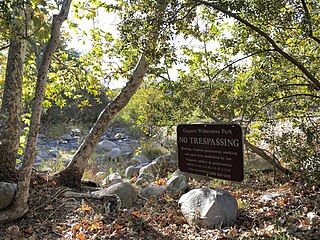
San Juan Hot Springs, also San Juan Capistrano Hot Springs, is a geothermal area in what is now Ronald W. Caspers Wilderness Park, near Cleveland National Forest, in Orange County, California in the United States. The springs were used by the Indigenous peoples of the region, and were an integral part of the dominion of Misíon San Juan Capistrano. They were later developed and used, on and off for a hundred years, as a resort area of post-settlement Southern California. The 52 springs were designated Orange County Historic Landmark No. 38 in 1989.
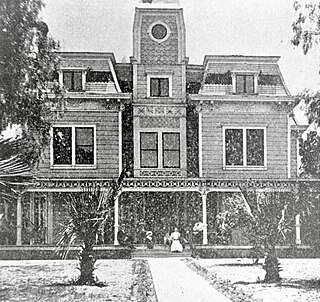
Fairview Hot Springs was a resort hotel in Fairview, California, United States from about 1887 to about 1918. The source of the water that constituted the "hot springs" was actually a well that yielded a combination of heated artesian water and natural gas. The Fairview Hot Springs was known for its mudbaths, but the Fairview development was already languishing, when—due to either financial failure generally, or the 1918 San Jacinto earthquake specifically—the resort hotel closed its doors for good around 1918.

Urbita Hot Springs was a historic hot springs and amusement park in San Bernardino County, California, United States. Urbita Springs Park was located between E Street and Colton Street in San Bernardino where the Inland Center mall stands today.






















